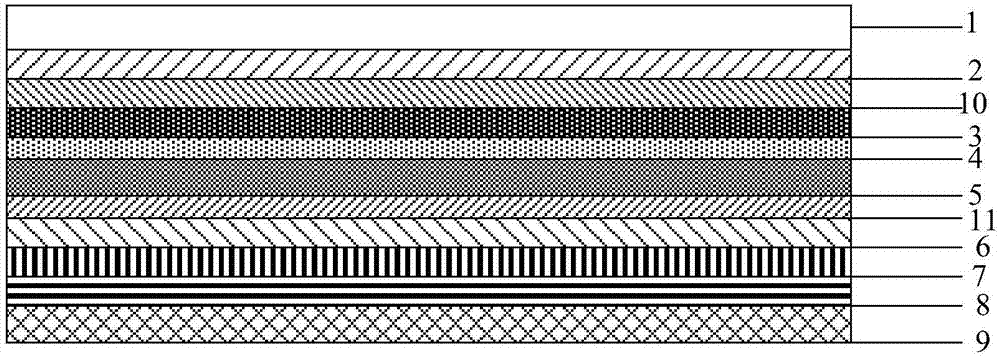EC (electrochromism) vacuum glass
A vacuum glass and electrochromic technology, applied in nonlinear optics, instruments, optics, etc., can solve the problems of ineffective control and other problems, and achieve the effects of less condensation, good sound insulation effect, and good uniformity of discoloration
- Summary
- Abstract
- Description
- Claims
- Application Information
AI Technical Summary
Problems solved by technology
Method used
Image
Examples
Embodiment 1
[0062] An electrochromic vacuum glass, comprising an inner layer glass 1, a transparent oxide upper conductive layer 2, a cathode electrochromic layer 3, an ion conductive layer 4, an anode electrochromic layer 5, and a transparent oxide lower conductive layer arranged sequentially. Layer 6, isolation layer 7, vacuum support layer 8 and outer glass 9. The schematic diagram of the structure of the electrochromic vacuum glass of this embodiment is as follows figure 1 shown.
[0063] The specific material and thickness of each layer in the above layers are shown in Table 1.
[0064] Table 1 The parameter data table of the electrochromic vacuum glass of this embodiment
[0065]
[0066]
[0067] Detect the performance of the electrochromic vacuum glass of this embodiment, specifically: thermal insulation performance K=0.56W / (m 2 K); dew point test temperature -60°C pasting time 4 minutes, no frost, no condensation; sound transmission requires a medium, the sound insulation ...
Embodiment 2
[0069] An electrochromic vacuum glass, comprising an inner Low-E glass 1, an upper transparent oxide conductive layer 2, a metal mesh upper conductive layer 10, a cathode electrochromic layer 3, an ion conductive layer 4, and an anode The electrochromic layer 5 , the conductive layer 11 under the metal mesh, the conductive layer 6 under the transparent oxide, the isolation layer 7 , the vacuum support layer 8 and the outer glass 9 . The schematic diagram of the structure of the electrochromic vacuum glass of this embodiment is as follows figure 2 shown.
[0070] The specific material and thickness of each layer in the above-mentioned layers are specifically shown in Table 2,
[0071] Table 2 The parameter data table of the electrochromic vacuum glass of this embodiment
[0072] name material thickness inner glass Low-E glass 6mm conductive layer on transparent oxide ITO (In 2 o 5 Sn)
Embodiment 3
[0074] An electrochromic vacuum glass, comprising an inner layer glass 1, an upper transparent oxidation insulating anti-penetration layer 12, a transparent oxide upper conductive layer 2, a cathode electrochromic layer 3, an ion conductive layer 4, and an anode electrochromic layer arranged sequentially. Color-changing layer 5 , transparent oxide lower conductive layer 6 , isolation layer 7 , vacuum layer 8 and outer glass 9 . The schematic diagram of the structure of the electrochromic vacuum glass of this embodiment is as follows image 3 shown.
[0075] name material thickness inner glass Low-E glass 6mm Upper transparent oxidation insulation anti-penetration layer SiO 2
PUM
| Property | Measurement | Unit |
|---|---|---|
| thickness | aaaaa | aaaaa |
| thickness | aaaaa | aaaaa |
| thickness | aaaaa | aaaaa |
Abstract
Description
Claims
Application Information
 Login to View More
Login to View More - R&D
- Intellectual Property
- Life Sciences
- Materials
- Tech Scout
- Unparalleled Data Quality
- Higher Quality Content
- 60% Fewer Hallucinations
Browse by: Latest US Patents, China's latest patents, Technical Efficacy Thesaurus, Application Domain, Technology Topic, Popular Technical Reports.
© 2025 PatSnap. All rights reserved.Legal|Privacy policy|Modern Slavery Act Transparency Statement|Sitemap|About US| Contact US: help@patsnap.com



